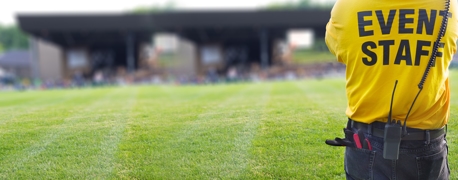What Makes Crowds Dangerous?

Not all crowds are volatile in nature, but when reaching a critical mass, crowds can become incredibly dangerous quickly. For this reason, planning is one of the most important ways to prevent dangerous crowd activities.
At a scheduled event, extensive planning is not only possible but necessary to ensure a safe experience for everyone. When crowd control plans are not implemented, those at the event may face disastrous consequences, like the 10 attendees who died and hundreds of others who suffered crowd crush injuries at Travis Scott’s Astroworld Festival in November 2021.
In 1993, John Fruin published a paper entitled “The Causes and Prevention of Crowd Disasters,” in which he writes,
“At occupancies of about 7 persons per square meter the crowd becomes almost a fluid mass. Shock waves can be propagated through the mass sufficient to lift people off of their feet and propel them distances of 3 m (10 ft) or more….Intense crowd pressures, exacerbated by anxiety, make it difficult to breathe.”
To understand how a crowd might reach this point, it’s important to first understand the concept of crowds themselves.
What Are the 4 Types of Crowds?
There is no consensus regarding the classification of crowds, but instead, there are a few different systems that have been created to help determine the intensity of or the reason for gathering. Generally, researchers have focused on the negative aspects of crowds, such as their potential for violence, although not all crowds are volatile in nature.
Sociologist Herbert Blumer explains that there are four different types of crowds, addressing each one’s emotional intensity:
- Casual crowd
- Conventional crowd
- Expressive crowd
- Acting crowd
Raymond Monboisse, on the other hand, focused on the crowds’ purposes for gathering:
- Casual crowd
- Conventional crowd
- Expressive crowd
- Aggressive crowd
Others such as AE Berlonghi developed a slightly different system of four types of crowds, still focusing on the purpose of existence:
- Spectator crowd
- Demonstrator crowd
- Escaping crowd
Herbert Blumer’s crowds are dynamic in nature; a single crowd can ebb and flow between the different types. Crowds that are large enough have the potential to turn dangerous due to a phenomenon called crowd surge.
What Causes Crowd Surge?
At certain critical densities, explains Dirk Helbing, a professor studying sociology and crowd modeling in Zurich, Switzerland, all forms of collective behavior disappear. It comes down to physics; “When the density goes up, then eventually peoples’ movements are constrained, and it becomes more like a fluid.”
Some of the most common causes of crowd surge include:
- The design of the event/venue. The density of the crowd should allow for individual movement.
- Overcrowding. When the venue or space allocated for an event is not large enough for the number of people attending, people are more likely to be in danger of crowd surge and crowd crush.
- Poor crowd management systems. Without effective procedures or safety measures in place, a crowd is much more difficult to control, and tragedy is harder to prevent.
- Lack of communication. This is related to poor crowd management systems; if people are not given a clear, safe path to move through, or security/medical response is not implemented, the crowd will continue to move as if nothing is wrong.
How Can Crowd Surge Turn Deadly?
When crowd surge occurs, people are often at the mercy of the movement of the crowd. In fact, a mass movement of people can lead to forces of over 4,500 Newtons, or 1,000 lbs. This level of exertion can bend steel railings and seriously injure those involved.
A report that looked into a crowd crush tragedy in 1989 at the Hillsborough soccer stadium in England said, “Survivors described being gradually compressed, unable to move…They were aware that people were dying and they were helpless to save themselves.”
There are many reasons why a person might be at risk of severe injury from a crowd surge. A crowd crush injury may impact a person in one of two ways: through trampling or suffocation. Doctors agree that being dehydrated or having an underlying condition such as asthma can place someone at higher risk of more traumatic injuries, or even death.
It is important to note that crowds turn dangerous when proper planning and security measures are not taken. Even the biggest crowd at a high-energy event can be properly managed and kept safe. When too many people are put in one area, security personnel are inexperienced, or there are simply not enough security and medical resources, serious injuries can happen.
Protecting Victims of Crowd Crush
At Arnold & Itkin, we are committed to getting the answers that those who have been injured in a crowd deserve. These tragedies don’t just happen; they are often caused by negligence and poor planning. If you have been injured in a crowd surge, you deserve justice.
When event organizers care more about their bottom line than the people attending, they need to be held responsible for the lives they change forever. Our crowd surge attorneys are determined to fight for what’s right, no matter what.


